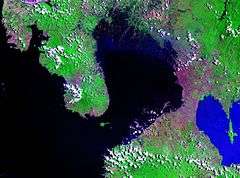Battle of Manila (1570)
The Battle of Manila (1570) (Spanish: Batalla de Manila en el 1570) was fought in Manila between the native Filipinos led by Rajah Sulayman, a vassal to the Sultan of Brunei and the Spaniards led by Martin de Goiti, Maestro de Campo on May 24, 1570. The forces under Goiti were victorious and as a result, Manila became the capital of the Spanish East Indies.
| Siege of Manila | |||||||
|---|---|---|---|---|---|---|---|
| Part of the Spanish colonization of the Philippines | |||||||
| |||||||
| Belligerents | |||||||
|
|
| ||||||
| Commanders and leaders | |||||||
|
|
| ||||||
| Battles of Manila |
|---|
| See also |
|
| Around Manila |
|
Events

By the late 1560s, Miguel López de Legazpi who had left Mexico with a retinue of Spanish and Mexican soldiers, was already searching for a more suitable place to establish the Spanish colonial capital, having found first Cebu and then Iloilo undesirable because insufficient food supplies and attacks by Portuguese pirates. He was in Cebu when he first heard about a well-supplied, fortified settlement to the north, and sent messages of friendship to its ruler, Rajah Matanda, whom he addressed as "King of Luzon."[1] In 1570, Legazpi put Martin de Goiti in command of an expedition north to Manila and tasked him with negotiating the establishment of a Spanish fort there.[2]
De Goiti arrived in May 1570, anchored at Cavite on the mouth of Manila Bay. He was initially well received by Maynila's ruler Rajah Matanda, who, as former commander of the Naval forces of the Sultanate of Brunei, had already had dealings with the Magellan expedition in late 1521. Negotiations broke down, however, when another ruler, Rajah Sulayman, arrived and began treating the Spanish belligerently, saying that the Tagalog people would not surrender their freedoms as easily as the "painted" Visayans did.[2][1][3][4] The accounts of the De Goiti mission report that Tondo's ruler, Lakandula, sought to participate in these negotiations early on, but De Goiti intentionally ignored Lakandula because he wanted to focus on Maynila, which Legaspi wanted to use as a headquarters because it was already fortified, whereas Tondo was not.[2]
By May 24, negotiations had broken down, and according to the Spanish accounts, their ships fired their cannon as a signal for the expedition boats to return. Whether or not this claim was true, the rulers of Maynila perceived this to be an attack and as a result, Sulayman ordered an attack on the Spanish forces still within the city. The battle was very brief because it concluded with the settlement of Maynila being set ablaze.[2][1][3]
The Spanish accounts claim that De Goiti ordered his men to set the fire,[2] historians today still debate whether this was true. Some historians believe it is more likely that the Maynila forces themselves set fire to their settlement, because scorched-earth retreats were a common military tactic among the peoples of the Philippine archipelago at the time.[1]
De Goiti proclaimed victory, symbolically claimed Maynila on behalf of Spain, then quickly returned to Legaspi because he knew that his naval forces were outnumbered.[2][1] Contemporary writers believe the survivors of Maynila's forces would have fled across the river to Tondo and other neighboring towns.
Aftermath
In 1571, the Spaniards returned with their entire force consisting of 280 Spaniards and Mexicans and 600 native allies from Panay, this time led by Legazpi himself. They successfully occupied Maynila by crushing the resistance posed by tens of thousands of native Muslim militia, and established a settlement there. On May 19, 1571, Legaspi gave the title city to the colony of Manila.[5]
A Kapampangan leader of the Macabebe tribe, later identified as Tarik Sulayman (from Arabic طارق سليمان Tāriq Sulaiman), refused to submit to the Spaniards and, after failing to gain the support of the kings of Manila (Lakandula, Matanda) and Hagonoy, Bulacan, gathered a formidable force composed of Kapampangan warriors. He subsequent fought and lost the Battle of Bangkusay Channel. The Spanish solidified their control over Manila and Legazpi was able to establish a municipal government for Manila on June 24, 1571, which eventually became the capital of the entire Spanish East Indies colony and subsequently the capital of the Philippines.
The initial population of the city was around 250.[6]
References
- Scott, William Henry (1994). Barangay: Sixteenth Century Philippine Culture and Society. Quezon City: Ateneo de Manila University Press. ISBN 971-550-135-4.
- Blair, Emma Helen; Robertson, James Alexander, eds. (1903). Relation of the Conquest of the Island of Luzon. The Philippine Islands, 1493-1898. 3. Ohio, Cleveland: Arthur H. Clark Company. p. 145.
- Dery, Luis Camara (2001). A History of the Inarticulate. Quezon City: New Day Publishers. ISBN 971-10-1069-0.
- Filipiniana: Act of Taking Possession of Luzon by Martin de Goiti. Accessed September 06, 2008.
- Riquel, Hernando de (1903). Blair, Emma Helen; Robertson, James Alexander (eds.). Foundation of the city of Manila, June 19, 1572. The Philippine Islands, 1493-1898. 3. Ohio, Cleveland: Arthur H. Clark Company. pp. 173–177.
- Joaquin, Nick (1990). Manila, My Manila. Vera Reyes, Inc. pp. 18–20.
Sources
- Relation of the Voyage in Luzon sa Blair & Robertson. The Philippine Islands, 1493-1803;Volume III, 1569-1576.
- Scott, William Henry. Barangay, Sixteenth Century Philippine Culture and Society. QC: Ateneo De Manila University Press, 1991.
